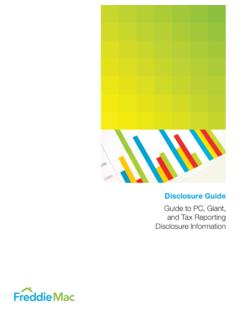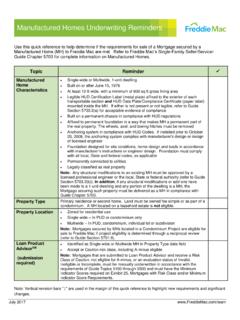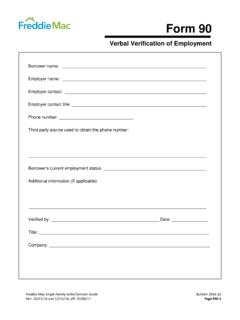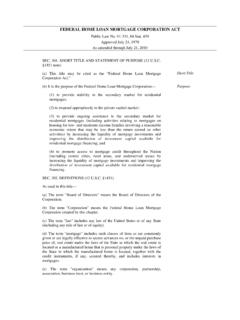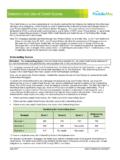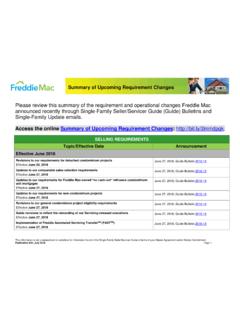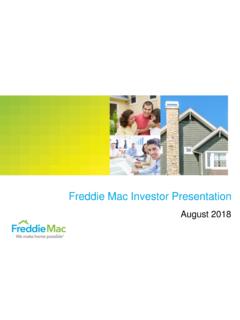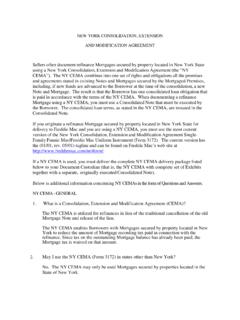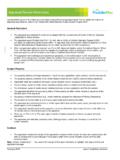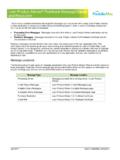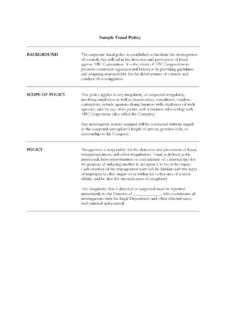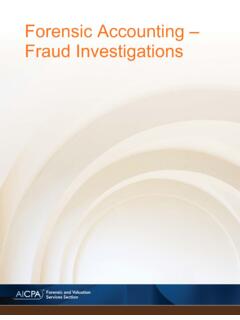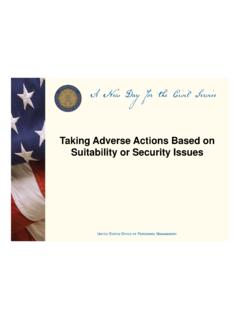Transcription of Fraud Mitigation Prevention Best Practices
1 Fraud Mitigation best Practices Single-Family July 2016 Fraud Mitigation best Practices July 2016 Page 2 Table of Contents Introduction .. 3 Seller/Servicer Requirements .. 3 Preventing Fraud .. 4 Employee Training & Awareness .. 4 Prudent Underwriting .. 5 Quality Control .. 6 Detecting Fraud .. 7 Origination .. 8 Common Origination Fraud Elements .. 8 Common Origination Fraud Schemes .. 11 Servicing .. 17 Detecting Fraud during Servicing of a Loan .. 17 Common Servicing Fraud Elements .. 18 Common Servicing Fraud Schemes .. 21 Investigating Fraud .. 26 List of Investigative Resources .. 26 Reporting Fraud and Other Suspicious Activity .. 28 Resolving Fraud .. 29 Freddie Mac Exclusionary 30 Fraud Mitigation best Practices Page 3 July 2016 Introduction Freddie Mac's Financial Fraud investigation Unit (FFIU) is responsible for the Prevention , detection, investigation , resolution, and reporting of Fraud and suspected Fraud (including mortgage and other financial instrument Fraud ) and other suspicious activity (as defined in the Freddie Mac Single-Family and Multifamily Seller/Servicer Guides).
2 Reliable and effective Fraud Prevention and detection programs are essential to the mortgage industry and also to law enforcement for the investigation and prosecution of mortgage Fraud -related crimes. Freddie Mac Seller/Servicers play an important role in preventing, detecting, and investigating potential mortgage Fraud and other suspicious activity, and are expected to report such activity to Freddie Mac. We are providing suggested best Practices in this document to assist you in establishing or improving your existing mortgage Fraud program. In addition, these Practices may help manage other suspicious activity risk at your institution. This is not an exhaustive discussion of Fraud Prevention and detection Practices . We encourage you to explore other resources and customize your Fraud and suspicious activity Prevention programs to reflect your company s organization, business operations, and needs. Seller/Servicer Requirements The information in this reference does not supersede or in any way alter the requirements in Freddie Mac s Single-Family Seller/Servicer Guide (Guide) or other Purchase Documents (as that term is defined in the Guide).
3 You must continue to meet all Guide requirements, including those related to Fraud Prevention , detection, and reporting, and Freddie Mac s Exclusionary List, as well as meet any applicable Bank Secrecy Act requirements. Refer to Guide Chapter 3201: Fraud Prevention , Detection and Reporting; Reporting Other Suspicious Activity, Guide Section : Freddie Mac Exclusionary List and Guide Section : Compliance with applicable law. Fraud Mitigation best Practices July 2016 Page 4 Preventing Fraud Employee Training & Awareness Employee training & awareness programs should include mortgage Fraud awareness in the loan origination and servicing areas. best Practices include: Fraud Risk Management Policies and Procedures: Put sound and appropriate Fraud detection, Prevention , investigation , resolution, and reporting policies and procedures in place and communicate them to employees.
4 Regulatory Compliance: Ensure appropriate policies and procedures are in place pertaining to your company s obligations under the Bank Secrecy Act, as applicable. Ethical Conduct: Familiarize employees with your company's standards for ethical conduct. New Employee Awareness: Incorporate mortgage Fraud awareness in new employee orientation programs. Training: Ensure that employees receive mortgage Fraud training appropriate for their roles and levels, including, but not limited to, those in the following business areas: (1) Initial loan application, underwriting, processing, and closing; (2) Prefunding and post funding quality control; and (3) Performing and non-performing loan servicing areas, including customer service, collection, loss Mitigation , foreclosure, bankruptcy, and escrow. Training should include: Current and common Fraud schemes and trends, including resources to recognize red flags that may signal the need for further review.
5 In addition to this best Practices reference, Mortgage Screening Process: Red Flags for Fraud includes supplemental information relating to red flags in application-related documentation. Clear directives for employee responsibilities when possible Fraud is suspected, including the process for escalating any red flags or suspicious incidents/activities within your organization and to Freddie Mac. Fraud Mitigation best Practices Page 5 July 2016 Information to ensure employees are familiar with the responsibilities of participants in mortgage and real estate transactions, including, but not limited to: Real estate brokers or agents Builders and/or developers Property sellers Correspondents Property buyers Property inspectors Loan officers Title insurers Mortgage brokers Closing or settlement agents Loan processors Third party service providers Underwriters Loan workout facilitators, , short sale negotiators Appraisers or other valuation providers To supplement your organization s employee training program, refer to Freddie Mac s Fraud resources.
6 Prudent Underwriting Prudent underwriting is often the cornerstone of your efforts to prevent Fraud . At a high level, best Practices include: Having well trained and qualified staff. Knowing your mortgage brokers. See Chapter 5 of the Wholesale Originations best Practices ( ). Knowing your appraisers, builder clients, real estate agents and others with whom you conduct business. Updating, maintaining, and following comprehensive written underwriting procedures. Performing due diligence reviews of loan files. Screening all loan parties through Freddie Mac s Exclusionary List (this is a Freddie Mac Seller/Servicer Guide requirement; see Guide Section ). To verify a potential match, contact the Financial Fraud investigation Unit at The Exclusionary List is available through: Fraud Mitigation best Practices July 2016 Page 6 - Loan Product Advisor under the Business Tools tab.
7 - Loan Selling AdvisorSM from the left navigation bar based upon your user role. - Single-Family Learning Center under Secured Resources for Servicers (requires Servicing Applications ID and password). For additional information on underwriting, refer to the following resources: For underwriting requirements, review Guide Chapters 5100 through 5500, Determining Borrower Eligibility through Assets (Borrower Funds and reserves); Guide Chapter 5601, Property and Appraisal Requirements, and any other relevant Purchase Documents. For underwriting best Practices , access the Originate and Underwrite webpage and training resources on the Freddie Mac Learning Center. For red flags that may be identified in loan documents, see Mortgage Screening Process: Red Flags for Fraud . Quality Control We recommend that you group and analyze your quality control results by the following areas, in order to identify potential trends for further review of possible Fraud : Branch office Processor Closing/escrow agent Loan officer Real estate agent Title company Broker Loan product Appraiser Underwriter Geographic area Property seller We also suggest you include the following in your quality control program (Note: Some of these are required by the Guide.)
8 : Provide and require relevant training and education. Conduct robust reporting for identification purposes and trending. Review loans from new or low-volume counterparties, with whom you have not previously done business, at a higher frequency rate than established counterparties. Use research tools to assist in the review process ( , collateral data records, public records, etc.). Conduct pre-funding quality control for high-risk loans, eg., based on LTV ratios, FICO scores, etc. Fraud Mitigation best Practices Page 7 July 2016 Pull for review random QC loan samples, as well as targeted loan samples. Re-verify and review all early payment defaults. Update, maintain and follow your quality control policies and procedures. Implement a well-defined escalation path for raising concerns and resolving issues If you suspect possible Fraud , report it: - to senior management, and - to Freddie Mac via the mortgage Fraud reporting mailbox at In addition to a quality control program, best Practices also include a quality assurance program for oversight and targeted training opportunities.
9 For quality control best Practices , review the Quality Control best Practices reference. You ll find a starting point for red flags in Mortgage Screening Process: Red Flags for Fraud . For quality control requirements, see Guide Chapter 3402. Also see Freddie Mac s training offering, Seller's in-House Quality Control Program. Detecting Fraud To help you identify mortgage Fraud , we ve described several common Fraud elements and possible Fraud schemes with their associated red flags in the sections below. Please keep in mind that a red flag is not proof of Fraud ; it is an indicator that something doesn t make sense or is inconsistent with what is expected. Each individual red flag listed in this reference may not be problematic in and of itself, but may warrant additional scrutiny when reviewed together with other red flags. Red flags must be reviewed promptly to determine if something is, in fact, wrong. Mortgage Fraud can occur at any stage of a loan from application through servicing.
10 Schemes can vary and often contain several of the same elements. This information is not intended to be all-inclusive. There are more types of Fraud than we can describe in this section and new schemes are continually emerging. Fraud Mitigation best Practices July 2016 Page 8 Origination Common Origination Fraud Elements These are some common elements typically found in Fraud schemes focused on loan origination: Inflated Property Valuation Inflated appraisals may contain fabricated or altered values and supporting information, or use inappropriate comparable sales (which may also contain false values and information). See Mortgage Screening Process: Red Flags for Fraud for appraisal-related red flags that may occur when inflated appraisals are used in the transaction. Loan-level Misrepresentations The loan application and supporting documentation may contain misrepresentations regarding employment, income, occupancy, down payment or equity contribution, and/or source of assets.
